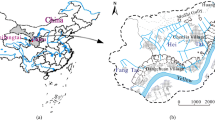Abstract
The strength and the related parameters of unsaturated soil are the key issues in unsaturated soil mechanics. The triaxial or direct shear apparatus with suction control is used to measure the related parameters in the strength formulas proposed by Bishop and Fredlund. However, the technique is time-consuming for cohesive soils because it takes a long time to achieve a water–air equilibrium condition under a given suction state. In addition, the feasibility of the technique is also doubted. Lu et al. proposed the concept of suction stress and expressed the unsaturated strength as a function of suction stress which can be determined by the conventional triaxial test. The method can avoid measuring matric suction and is convenient in engineering application. In this paper, conventional triaxial CU tests with different moisture contents were utilized to obtain the effective steady state strength parameters and then the suction stress characteristic curves were obtained. To compare Lu et al.’s strength formula with Bishop’s and Fredlund’s, the soil–water characteristic curve of the same loess sample was also measured by the tensiometer. Theoretically, the three strength theories are different in physical mechanisms, but they can transform to each other mathematically. From the point of view of engineering applications, Lu et al.’s shear strength theory based on suction stress is more convenient to apply in engineering.
















Similar content being viewed by others
References
Bishop AW (1959) The principle of effective stress. Teknisk Ukeblad 106:859–863
Bishop AW, Alpan I, Blight GE, Donald IB (1960) Factors controlling the strength of partly saturated cohesive soils. In: Research conference on shear strength of cohesive soils, Boulder, ASCE, pp 503–532
Coleman JD (1962) Stress–stain relations for partly saturated soils. Geotéchnique 12:348–350
Fredlund DG, Rahardjo H (1993) Soil mechanics for unsaturated soils. Wiley, New York
Fredlund DG, Xing A (1994) Equations for the soil-water characteristic curve. Can Geotech J 31:521–532
Fredlund DG, Morgenstern NR, Widger RA (1978) The shear strength of unsaturated soils. Can Geotech J 15:313–321
Fredlund DG, Rahardjo H, Fredlund MD (2012) Unsaturated soil mechanics in engineering practice. Wiley, Hoboken
Jennings JEB, Burland JB (1962) Limitation to the use of effective stresses in partly saturated soils. Géotechnique 12:125–144
Khalili N, Geiser F, Blight GE (2004) Effective stress in unsaturated soils, a review with new evidence. Int J Geomech 4:115–126
Lu ZJ (1999) Explorations on the suctional shear strength of unsaturated soils. China Railw Sci 20:10–16 (In Chinese with English abstract)
Lu N (2008) Is matric suction a stress variable? J Geotech Geoenviron Eng 134:899–905
Lu N, Goat JW (2013) Hillslope hydrology and stability. Cambridge University Press, New York
Lu N, Likos WJ (2004) Unsaturated soil mechanics. Wiley, New York
Lu N, Likos WJ (2006) Suction stress characteristic curve for unsaturated soil. J Geotech Geoenviron Eng ASCE 132:131–142
Lu N, Godt JW, Wu DT (2010) A closed-form equation for effective stress in unsaturated soil. Water Resour Res. doi:10.1029/2009WR008646
Skempton AW (1960) Significance of Terzaghi’s concept of effective stress (Terzaghi’s discovery of effective stress). In: Bjerrum L, Casagrande A, Peck RB, Skempton AW (eds) From theory to practice in soil mechanics. Wiley, New York, pp 42–53
Terzaghi K (1943) Theoretical soil mechanics. Wiley, New York
Acknowledgments
The authors express their gratitude to the members of research group for their contributions and involvement in the experiment. This work was financially supported by the Research Fund for the Excellent Doctor of Higher Education of China (No.310826150005), the Research Fund for the Doctoral Program of Higher Eduction of China (No. 20120205110009), the National Key Fundamental Research Program of China (No. 2014CB744703) and National Natural Science Foundation of China (No. 41172256), and the support of these agencies is gratefully acknowledged. The authors would also like to acknowledge anonymous reviewers for the valuable suggestions to this article.
Author information
Authors and Affiliations
Corresponding author
Rights and permissions
About this article
Cite this article
Xing, X., Li, T. & Fu, Y. Determination of the related strength parameters of unsaturated loess with conventional triaxial test. Environ Earth Sci 75, 82 (2016). https://doi.org/10.1007/s12665-015-4797-5
Received:
Accepted:
Published:
DOI: https://doi.org/10.1007/s12665-015-4797-5




